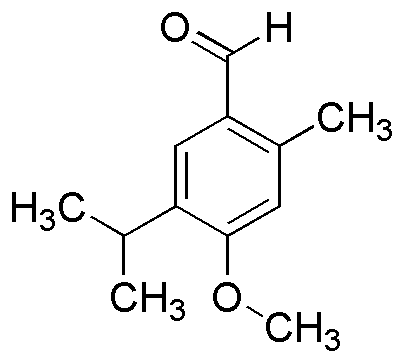5-Isopropyl-4-methoxy-2-methylbenzaldehyde is widely utilized in research focused on:
- Fragrance Industry: This compound is often used as a key ingredient in perfumes and fragrances, providing a unique aromatic profile that enhances the overall scent experience.
- Flavoring Agents: It serves as a flavoring agent in food products, contributing to the taste and aroma of various culinary creations, particularly in baked goods and confections.
- Pharmaceuticals: The compound is explored in the development of new drugs, particularly in the synthesis of pharmaceutical intermediates, offering potential therapeutic benefits.
- Cosmetics: Its properties make it suitable for use in cosmetic formulations, where it can enhance product appeal through its scent and possibly beneficial effects on skin.
- Research Applications: In academic and industrial research, it is utilized as a building block in organic synthesis, aiding in the creation of more complex chemical structures.
Informations générales
Propriétés
Sécurité et réglementation
Applications
5-Isopropyl-4-methoxy-2-methylbenzaldehyde is widely utilized in research focused on:
- Fragrance Industry: This compound is often used as a key ingredient in perfumes and fragrances, providing a unique aromatic profile that enhances the overall scent experience.
- Flavoring Agents: It serves as a flavoring agent in food products, contributing to the taste and aroma of various culinary creations, particularly in baked goods and confections.
- Pharmaceuticals: The compound is explored in the development of new drugs, particularly in the synthesis of pharmaceutical intermediates, offering potential therapeutic benefits.
- Cosmetics: Its properties make it suitable for use in cosmetic formulations, where it can enhance product appeal through its scent and possibly beneficial effects on skin.
- Research Applications: In academic and industrial research, it is utilized as a building block in organic synthesis, aiding in the creation of more complex chemical structures.
Documents
Fiches de données de sécurité (FDS)
La FDS fournit des informations de sécurité complètes sur la manipulation, le stockage et l’élimination du produit.
Spécifications du produit (PS)
Le PS fournit une description complète des propriétés du produit, notamment sa composition chimique, son état physique, sa pureté et les exigences de stockage. Il détaille également les plages de qualité acceptables et les applications prévues du produit.
Certificats d'analyse (COA)
Recherchez des certificats d'analyse (COA) en saisissant le numéro de lot du produit. Les numéros de lot et de lot se trouvent sur l'étiquette d'un produit, après les mots « Lot » ou « Lot de fabrication ».
Numéro de catalogue
Numéro de lot/série
Certificats d'origine (COO)
Ce certificat d'exploitation confirme le pays dans lequel le produit a été fabriqué, et détaille également les matériaux et composants utilisés et s'il est issu de sources naturelles, synthétiques ou autres sources spécifiques. Ce certificat peut être requis pour les douanes, le commerce et la conformité réglementaire.
Numéro de catalogue
Numéro de lot/série
Fiches de données de sécurité (FDS)
La FDS fournit des informations de sécurité complètes sur la manipulation, le stockage et l’élimination du produit.
DownloadSpécifications du produit (PS)
Le PS fournit une description complète des propriétés du produit, notamment sa composition chimique, son état physique, sa pureté et les exigences de stockage. Il détaille également les plages de qualité acceptables et les applications prévues du produit.
DownloadCertificats d'analyse (COA)
Recherchez des certificats d'analyse (COA) en saisissant le numéro de lot du produit. Les numéros de lot et de lot se trouvent sur l'étiquette d'un produit, après les mots « Lot » ou « Lot de fabrication ».
Numéro de catalogue
Numéro de lot/série
Certificats d'origine (COO)
Ce certificat d'exploitation confirme le pays dans lequel le produit a été fabriqué, et détaille également les matériaux et composants utilisés et s'il est issu de sources naturelles, synthétiques ou autres sources spécifiques. Ce certificat peut être requis pour les douanes, le commerce et la conformité réglementaire.


